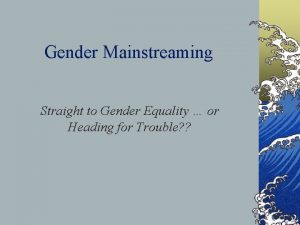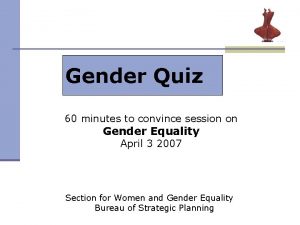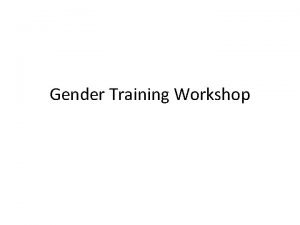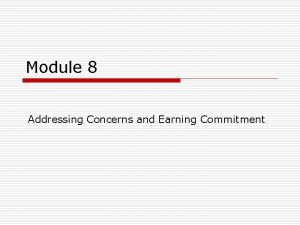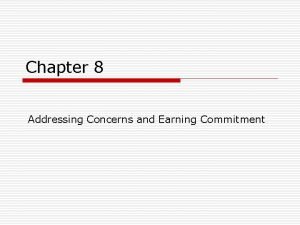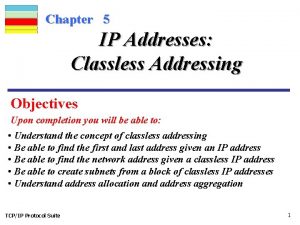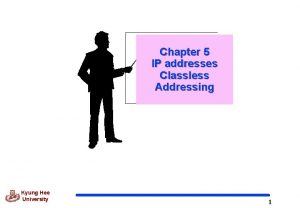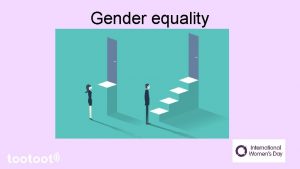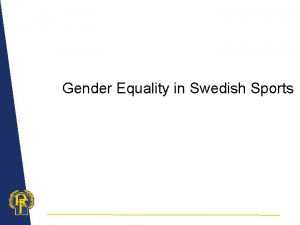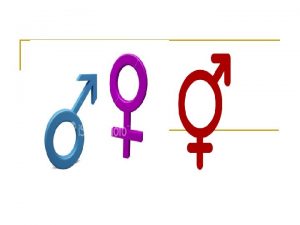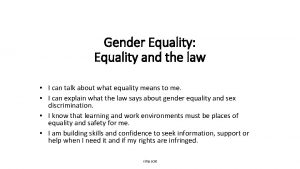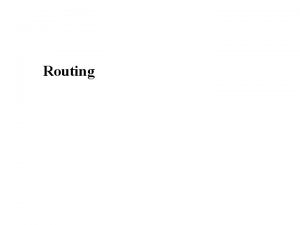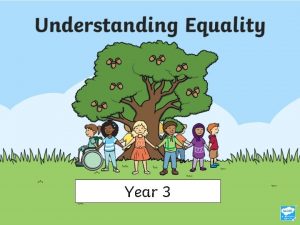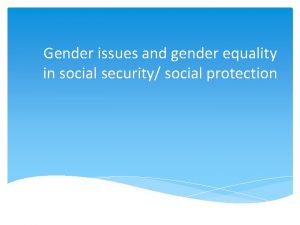Topic 1 Understanding Gender and Gender Equality Addressing


























- Slides: 26

Topic 1: Understanding Gender and Gender Equality Addressing school-related gender-based violence (SRGBV): A four-day training for master trainers

Session 1 B: objectives • To sample the learning activities from Topic 1: 1 B: Gender and Power • understand sex vs. gender • To understand gender norms and how they are passed on in society. • To identify what schools do that reinforces gender norms • To identify what schools can do to change negative gender norms

Structure of the classroom program Part 1: Understanding gender and gender equality Part 2: Raising Part 3: Developing skills awareness about for respectful gender-based violence relationships Topic 1: Gender Topic 3: and equality Awareness of gender-based Topic 2: Gender violence equality and positive rolemodels Topic 5: Communication skills for respectful relationships Topic 4: A focus on school-related Topic 6: Skills for gender-based people who violence witness violence Topic 7: Helpseeking and peer support skills

Activities in Topic 1: Understanding Gender and Gender Equality Activities in this Topic: Activities we will sample: Activity 1: What is gender? ✓ Activity 2: Unpacking gender norms ✓ Activity 3: Messages about males & females in the media ✓ Activity 4: Challenging negative gender norms ✓ Activity 5: Challenging myths

Understanding the approach • It is important to help students to understand the concept of ‘gender’ and the way in which gender norms influence the behaviour and treatment of males and females. • Students need to understand key words and concepts • Students become aware of the way in which gender norms are learnt from the world around them. • Scenarios are used to help students to map their understanding of gender in relation to their life experiences • Build optimism about the capacity of people to change negative norms, whilst protecting positive social norms.

What is Gender? Sex Is used to identify the biological or physical differences between the bodies of men and women (e. g. being born male or female). Gender Is used for the differences that are created as a result of the social and cultural expectations and norms about what it means to “be a man” or to “be a woman”.

Topic 1, Activity 1: What is gender? • What are some of the words we think of to describe a female / a male? • Make a ‘word web’ on the board with the words provided by the students. • Which of your answers relate to sex, and which relate to gender? ? ? ? Female Male ? ? ?

It is important to build shared definitions Gender Violence Gender-based Violence (GBV) School Related Gender Based Violence (SRGBV)

How do we ‘learn’ Gender? • Differences between the genders are learnt through modelling and observation, and passed from one generation to the next • Gender norms can, and do, change over time • Norms include ideas and practices such as about how to dress, speak and behave • Commonly males are expected to be strong, powerful and in control, and females are expected to be submissive, obedient and attractive

The influence of traditional gender norms • Gender norms are present in all cultures and societies • Gendered practices are passed down through culture and tradition and institutions and everyday practices • Not all gender norms are harmful • Some gender norms lead to exploitation, unequal treatment or vulnerability • 2011 qualitative study by Muhanguzi in Uganda interviewed girls from 14 schools. It found that girls are vulnerable to victimisation and inequality within the school, and feel they have to please boys • 2015 study by Moma investigated school yard experiences of 30 girls in South African schools. The playground was named as a key site of studentperpetrated sexual violence.

More key words • Gender Identity: This term is used to describe who you feel you are – whether you think or feel you are male or female or something in between. • Gender Expression: How you show who you are. For example what you call yourself or like other to call you, the way you dress and behave… • Biological Sex: The physical body you were born with. • Sexual Orientation: Who you are sexually attracted to. • Sexual Expression: Who you choose to have sexual contact with.

Topic 1, Activity 2: Unpacking gender norms Learning objectives • In this activity students will: • Consider how gender norms differently influence people’s experiences • Identify the way in which gender norms can differ from one community to another, and can change over time • Identify ways in which gender norms can lead to harmful practices and behaviours, including inequality, discrimination, exclusion, violence and risk-taking

Activity: learning gender ‘rules’ Remember a time when you were young, and you were ‘taught’ or came to learn a ‘rule’ or expectation which was different for boys versus girls, or men versus women

Activity 2: Unpacking gender norms • Work together to complete the chart • identify some different expectations placed on males and females at different ages. Expectations males for At age 5 At age 10 At age 15 In adulthood females both

This activity helps students to learn that: • Gender norms and expectations influence how males and females live their lives. • Some gender norms are harmful and can stop females and males doing what they believe is right for them. • Recognising gender norms helps people to question the fairness of the roles and challenge those practices that are unjust and harmful. • Gender norms and expectations have a strong influence on how males and females experience life (this can be positive or negative).

Brain Game: Pass the clap • Stand in a large circle • A leader claps and this is passed around the circle in a chain reaction • In the next round, change the direction of the clap • Discuss: What are the key messages in this game that relate to the way in which gender norms are learned?

Topic 1, Activity 3: Messages about males & females in the media Learning objectives In this activity students will: • Explore how gender norms are reinforced in the media and other social spaces

Topic 1, Activity 3: Messages about males & females in the media and literature Discuss with a partner: What do you notice about gender roles in some of your favourite TV shows? • What are the differences between the male and female characters? • Are there any characters that do not fit within the typical gender norms? • How are they treated? • What does this ‘teach’ children about how and who to be?

This activity helps students to learn that: • The media is filled with stories that show stereotypical gender roles and norms. These lead to restricted choices for males and females. • The stories in the media can influence how we think about gender roles and norms. • We need to think critically about the way males and females are shown in the media so we can challenge limiting and harmful stereotypes.

Topic 1, Activity 4: Challenging negative gender norms Learning objectives In this activity students will: • Develop strategies and plans for challenging negative gender norms

Topic 1, Activity 3: Challenging negative gender norms • In a pair, choose one When this is said…. What could this scenario from the table • Script a response with your group • Act out the conversation (one person as provocateur and one ‘speaking back’) • Perform your conversation to the group character say? ‘Boys can’t cook – cooking is a woman’s job’ The boy who wants to cook could say … ‘I know you like school but it is time to stop study and start finding a husband’ The 15 year old girl who wants to get a good education could say … ‘You are too scared to join in’ The 15 year old boy could say …

This activity helps students to learn that: • It is important to challenge gender norms and expectations that limit or cause harm so as to create gender-fair families, schools and communities. • There are many things people can say to challenge harmful and unjust gender stereotypes and norms.

Take a look at the Classroom Program • Have a look at Topic 1 activities in your copies of the classroom program • How would you use or refine activities for delivery in your schools? • Which subjects could they be delivered in?

Key messages The students learn: • The difference between the terms ‘sex’ and ‘gender’ • That gender roles and expectations can be unfair, limiting and harmful, and can and should be changed. • That gender norms are learnt early in childhood and continue to shape people’s beliefs and behaviours • That media and family and schools all work to ‘teach’ gender norms • It is important for people to question and think about gender norms • It is important for people to show respect for all, regardless if people do not conform to gender stereotypes.

Key messages • Gender is socially learnt and passed on; but sex is determined at birth. • It is important to develop shared definitions relating to gender and violence • Gender norms can and do change • Common gender norms include the expectation that males will be strong, powerful and in control, and females will be submissive and obedient. • Schools help to pass on gender norms. They can work to change negative norms. They can teach social and emotional skills, and can play an important role in the prevention of gender based violence

Optional Activity : Gender Freezeframes In this activity students: • Learn about the difference between the terms sex and gender Task: Gender freeze frames • Make a statue or sculptures of men / women / adolescent girl / adolescent boy. • Create another “statue” or freeze frame to illustrate a change in the position of the character that you would like to see in the future. • Practice moving between the two images • Read the images. What do they tell us? • Alternative: Make a word web of words associated with man/boy and girl/woman. • Mark the words that are biological and those that are learnt or cultural
 Flat addressing vs hierarchical addressing
Flat addressing vs hierarchical addressing Substantive equality vs formal equality
Substantive equality vs formal equality Formal equality vs substantive equality
Formal equality vs substantive equality Strategic gender needs and practical gender needs
Strategic gender needs and practical gender needs Mwyssa
Mwyssa Rhetorical questions about gender equality
Rhetorical questions about gender equality Gender equality definition
Gender equality definition What is gender equality answer
What is gender equality answer Methodology of gender inequality
Methodology of gender inequality Kothari commission structure
Kothari commission structure Slam spoken word poetry
Slam spoken word poetry Example of gender equality
Example of gender equality Slogan about discrimination
Slogan about discrimination Gender inequality case study
Gender inequality case study Examples of clincher sentences
Examples of clincher sentences Research problem example for students
Research problem example for students Addressing concerns and earning commitment
Addressing concerns and earning commitment What is classful addressing?
What is classful addressing? Classless subnet
Classless subnet Addressing concerns and earning commitment
Addressing concerns and earning commitment Difference between classful and classless addressing
Difference between classful and classless addressing Classless addressing
Classless addressing Copyright
Copyright Supernetting vs subnetting
Supernetting vs subnetting Chapter 12 addressing competition and driving growth
Chapter 12 addressing competition and driving growth Acars format
Acars format Superlative comparative and equality
Superlative comparative and equality






